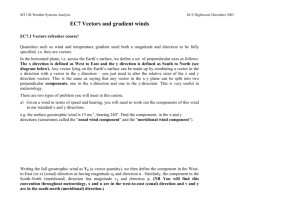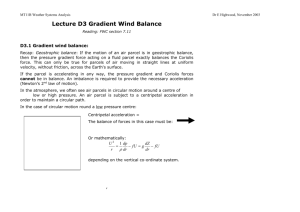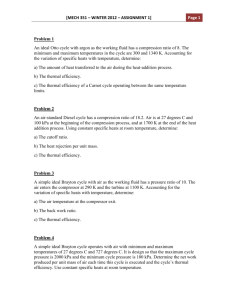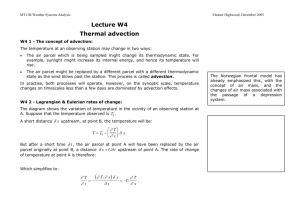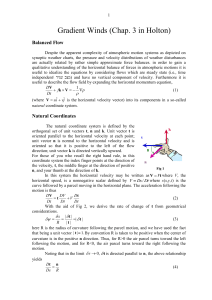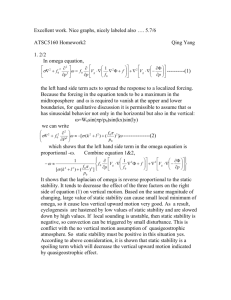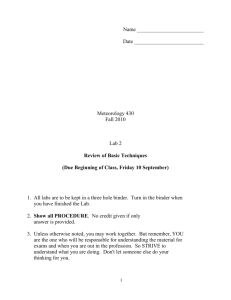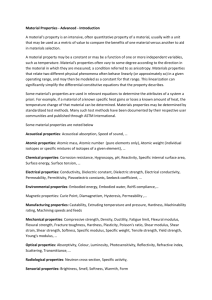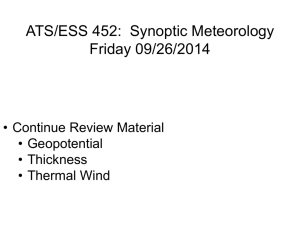Document 7531735
advertisement
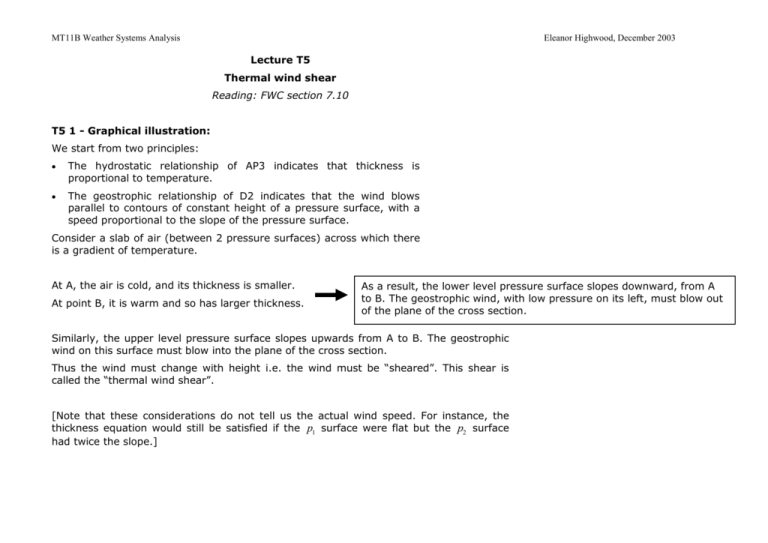
MT11B Weather Systems Analysis Eleanor Highwood, December 2003 Lecture T5 Thermal wind shear Reading: FWC section 7.10 T5 1 - Graphical illustration: We start from two principles: The hydrostatic relationship of AP3 indicates that thickness is proportional to temperature. The geostrophic relationship of D2 indicates that the wind blows parallel to contours of constant height of a pressure surface, with a speed proportional to the slope of the pressure surface. Consider a slab of air (between 2 pressure surfaces) across which there is a gradient of temperature. At A, the air is cold, and its thickness is smaller. At point B, it is warm and so has larger thickness. As a result, the lower level pressure surface slopes downward, from A to B. The geostrophic wind, with low pressure on its left, must blow out of the plane of the cross section. Similarly, the upper level pressure surface slopes upwards from A to B. The geostrophic wind on this surface must blow into the plane of the cross section. Thus the wind must change with height i.e. the wind must be “sheared”. This shear is called the “thermal wind shear”. [Note that these considerations do not tell us the actual wind speed. For instance, the thickness equation would still be satisfied if the p1 surface were flat but the p2 surface had twice the slope.] MT11B Weather Systems Analysis Eleanor Highwood, December 2003 T5 2 - Mathematical derivation: Let us derive a formula for this shear. The shear is merely the change in wind with height, and we know from above that it depends on the temperature gradient in the horizontal. Doing the usual thing of splitting the geostrophic wind into components in the N-S and E-W direction (remember EC7) we need to find: a) Change of E-W component of geostrophic wind with pressure, u g Z u g p , or with height, . And b) Change of S-N component of geostrophic wind with pressure, c) And relate these to the horizontal gradients in temperature, vg p T x , or with height, and T y vg Z . . From the hydrostatic relationship we know that how Z varies with p depends on T, Z RT . p pg Differentiate with respect to y to give us a temperature gradient on one side of the equation: 2Z R T . p y pg y (1) Secondly, we can define ug in terms of the horizontal gradient of geopotential height by re-arranging the geostrophic relationship in the form: Remember that vg p is an example of partial differentiation. This means that although vg is really a function of may variables, we are just considering the rate of change of vg with respect to p while holding the remaining variables fixed. In general for a variable G being a function of x,y,p and t G(x,y,p,t)=x2+y3+2p+t Then partial differentiation gives G G G 2x , 2, 3x 2 , x p y G 1 t The rule are the same as in ordinary differentiation. Those of you doing maths lectures in the summer term will cover the theory. MT11B Weather Systems Analysis Eleanor Highwood, December 2003 fu g Z y g We want the change in ug with pressure so we differentiate both sides with respect to p: 2Z f ug . y p g p (2) But in a mixed second derivative (as on the left hand sides of both equations 1 and 2), the order of differentiation is irrelevant. So Z can be eliminated between the two expressions to give: ug R T . p pf y Similarly we can obtain vg R T . p pf x This is a mathematical expression for the thermal wind shear. Sometimes, it is more convenient to express the thermal wind shear using height rather than pressure as a vertical coordinate. The corresponding expressions are: ug vg g T g T and . Z fT y Z fT x T5 3 - The thermal wind: Meteorologists frequently consider the thickness of the 100-50 kPa layer, and so are concerned with the wind shear between these two levels. “The thermal wind” = the vector difference between the geostrophic wind at 100 kPa and 50 kPa. For revision purposes make sure you can derive (i.e. follow the maths from the start of T5.2) for both these relationships and get to the versions using height rather than pressure (hint – use the hydrostatic relationship again). MT11B Weather Systems Analysis Eleanor Highwood, December 2003 The thermal wind, denoted v T , is a vector parallel to the contours of thickness, with cold air on the left (on the right in the southern hemisphere). The magnitude of the “thermal wind” VT is easily calculated using the formulae for the geostrophic wind. Consider two levels denoted by subscript 1 and 2. Suppose for simplicity that the height contours are parallel at both levels. Then: Vg1 g Z1 g Z2 . , Vg 2 f y f y Subtract these two equations to find: VT Vg 2 Vg1 g ( Z2 Z1 ) f y And so the thermal wind is easily related to the horizontal gradient in thickness (and so could be found from a thickness chart for example). This relationship between horizontal temperature gradients and vertical wind shears is what gives rise to many important features of atmospheric circulations, e.g. the jets above the frontal surfaces in frontal cross sections, and on a larger scale, the mid-latitude westerly jets are a result of the equator to Pole temperature gradient. You can use this relationship to calculate the temperature gradient if you know the wind shear, or vice versa. You’ll see more examples in EC9. MT11B Weather Systems Analysis Eleanor Highwood, December 2003 Worked Example: A radiosonde ascent at 52N records a wind of 10 m s-1, bearing 240 at 90 kPa and 20 m s-1, bearing 270 at 50 kPa. Work out the direction of the isotherms and the magnitude of the temperature gradient, assuming it to be constant between 90 and 50 kPa. Step 1: decompose the winds into components parallel to the x (W-E) and y (S-N) axes. The results are: 1 - At 90 kPa, u = 8.7 m s-1, v = 5.0 m s-1, 2 - At 50 kPa, u = 20.0 m s-1, v = 0.0 m s-1. Step 2: Use u / p u / p , etc., so that u / p is -2.8310-4m s-1Pa-1 and v / p is 1.2510-4m s-1Pa-1. (We must take care with signs in these examples remembering that pressure decreases as you go to higher heights in the atmosphere.) Step 3: From the thermal wind equations we can find the horizontal temperature gradients: T T pf u pf v 350 . 10 6 K m -1 . 7.93 10 6 K m-1 , x R p y R p Step 4: The temperature gradient is a vector with components T / x, T / y : its magnitude is T / x 2 T / y 2 , i.e., 8.710-6 K m-1 (8.7 K per 1000 km). Step 5: The direction of the temperature gradient is calculated from , and works out at 66 to the zonal direction (draw it if you aren’t tan 1 T / y T / x sure). Then the direction of the isotherms is perpendicular to the direction of the temperature gradient and works out at 90-66 = 24 to horizontal. You will get plenty of practice in this in EC9.
